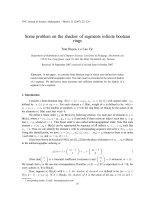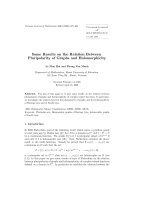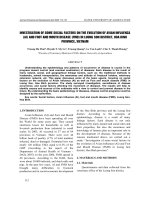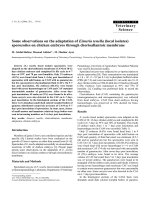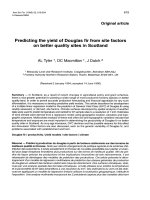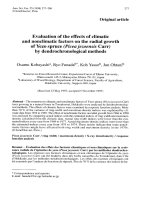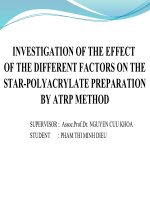Effect of some factors on the quality of black bean sprouts
Bạn đang xem bản rút gọn của tài liệu. Xem và tải ngay bản đầy đủ của tài liệu tại đây (395.15 KB, 10 trang )
An Giang University Journal of Science – 2019, Vol. 6, 70 – 79
EFFECT OF SOME FACTORS ON THE QUALITY OF BLACK BEAN SPROUTS
Ho Thi Ngan Ha1
An Giang University
1
Information:
Received: 01/10/2017
Accepted: 02/12/2017
Published: 02/2019
Keywords:
Black bean sprouts, soaking,
substrate, sowing density,
anthocyanin
ABSTRACT
Black bean sprouts are high in nutritional value with vitamins, minerals,
amino acids, fiber, vitamin C and anthocyanin. The study was conducted as
following: Black beans were soaked at temperatures of 25 °C, 30 oC, 35 oC,
40 oC and for period of 2 hours, 3 hours, 4 hours, 5 hours. The substrates
were surveyed as ash, cotton towel, sand and paper tissue. Seeds were sown
at density of 25 seeds, 50 seeds, 75 seeds, 100 seeds in the same unit area of
60 cm2. The times of irrigation were investigated with once, twice, three
times for the substrate in a day. Finally, the study compared the differences
in nutrients content of black bean sprouts and green bean sprouts as well as
evaluated the sensory of two products. The results of the study showed that:
soaking black beans at 30oC for four hours gave the best germination ability.
The most suitable type of substrate was sand. The appropriate sowing density
was 75 seeds /60 cm2. The optimal number of irrigation every day was twice.
Nutrients content of black bean sprouts and green bean sprouts were as
following: Moisture (82.2%, 86.4%), Protid (7.7%; 8.1%), total sugar
(11.7%; 12.3%), vitamin C (34.10 mg%; 28.50 mg %), anthocyanin (6.8
mg/kg; 0mg/kg). The sensory evaluation result showed that black bean
sprouts were more highly appreciated by consumers for structure and
preference.
1. INTRODUCTION
have not been studied. In the world, Japan, USA,
and EU countries have studied the germination of
black bean and application it to the
pharmaceutical field. In addition to the basic
nutrients, black bean sprouts also contain
antioxidants (including anthocyanin, phenolic,
flavonoid, saponin) that prevent cardiovascular
disease and inhibit growth of cancer cells (such as
liver cancer, breast cancer, prostate cancer, and
colon cancer) (Daniel, Sergio & Janet, 2013). In
addition, the current demand for safe vegetables is
necessary for our country. From the above
reasons, the study investigated some factors that
Bean sprout is a kind of vegetable that is found in
many popular traditional foods in the world,
especially in Asian countries like Vietnam, Japan,
South Korea, Thailand, Malaysia, China and also
well known in Western culinary culture. Bean
sprouts have nutrients such as essential amino
acids, vitamins and minerals. The process of
producing bean sprouts is simple, at low cost,
does not take much time. In Vietnam, black bean
quantity is quite large, and it can be produced to a
variety of foods such as black bean powder, black
bean milk, etc but black bean sprouts for food
70
An Giang University Journal of Science – 2019, Vol. 6, 70 – 79
affected the germination ability of black bean
sprouts to create a new food product from black
beans with nutrients and health benefits in order
to meet the social demand. The study also
compared the content of some nutrients,
especially anthocyanin, as well as the sensory
properties of black bean sprouts with green bean
sprouts to demonstrate the quality of black bean
sprouts.
Statgraphics plus 5.0 with a significance test
through LSD at the confidence level of 95% (P =
0.05).
2.3 The procedure for producing black bean
sprouts
Black beans were selected to remove unsavory
seeds and washed with clean water to remove
impurities and some microorganisms from the
surface. Seeds were soaked in washed water. Then
they were rinsed with clean water to remove
acidic water on the surface. Beans were drained
before sowing to avoid the rot when planting.
After that, beans were sown on the substrate and
kept at 30oC. During incubation, the substrate was
irrigated with water. All samples are harvested
after five days to identify the indicators.
2. MATERIALS AND METHODS
2.1 Materials
-
-
-
-
Black beans: they were bought at Long Xuyen
market, An Giang province. New bean seeds
were harvested for less than three months,
dried, shiny black, smooth, non-damaged and
had a uniform size.
Water: used domestic water attained to TCVN
5502-2003 for irrigation.
Substrates:
• Sand: used raw black sand of construction
to meet the TCVN 7570-2006.
• Cotton towel: used a thin one having the
size of (28x28) cm and weight of 25 g.
• Paper tissue: used a napkin.
• Ash: used ash from wood stoves and
removed all impurities.
Chemicals were used for analysis: Diethyl
ether, NaOH, HCl, Na2SO4, H2SO4, K2SO4,
CuSO4, phenolphthalein, iodine, alcohol
(China). They were supplied by Anh Vu Co.
(Ho Chi Minh City).
Instruments:
• Analytical balance (Ohus): accuracy
0.0001 g
• Incubator (Memmert)
• Spectrophotometer (SP1920)
2.4 Contents of study
2.4.1 Experiment 1: Investigation of effect of
soaking temperature and period on
germination ability
The experiment was arranged randomly with two
factors:
-
Factor A: Soaking temperature (oC)
A1: 25
A3: 35
-
A2: 30
A4: 40
Factor B: Soaking period (hours)
B1 : 2
B3 : 4
B2 : 3
B4 : 5
Permanent parameters:
-
2.2 Method of experimental layout and data
processing
Beans content: 7 g (50 - 55 seeds)
The ratio of beans to water for soaking: 1:30
Type of substrate: sand 200 g
Sowing area: 60 cm2
Irrigation water content: each 30 ml, 3 times/
day
2.4.2 Experiment 2: Investigation of effect of
substrate types on germination ability
The experiments were arranged randomly with the
factors and three replications, indicated data was
the mean value. Collected data was graphed by
using Microsoft Excel and statistically processed
by the ANOVA analysis method using
The experiment was arranged randomly with one
factor:
71
Factor C: Substrate types
An Giang University Journal of Science – 2019, Vol. 6, 70 – 79
C1: Sand
C2: Cotton towel
C4: Ash
C3: Paper tissue
2.4.4 Experiment 4: Investigation of effect of
watering times on germination ability
The experiment was arranged randomly with one
factor:
Permanent parameters:
-
Beans content: 7 g (50 - 55 seeds)
The ratio of beans to water for soaking: 1:30
Soaking temperature and period: optimal
values selected from experiment 1
The weight of substrates: sand 200 g, ash 200
g, cotton towel 100 g, paper tissue 50 g
Sowing area: 60 cm2
Irrigation water content: each 30 ml, 3 times/
day
-
E1: 1
E3 : 3
-
The experiment was arranged randomly with
one factor:
-
Factor D: Sowing density (seeds / 60 cm2)
D1: 25
D3: 75
-
The ratio of beans to water for soaking: 1:30
Soaking temperature and period: optimal
values selected from experiment 1
Type of substrate: optimal type selected from
experiment 2
Sowing density: optimal value selected from
experiment 3
Irrigation water content: each 30 ml
2.4.5 Comparison of differences in content of
nutrients and sensory properties of black
bean sprouts and green bean sprouts
D2: 50
D4: 100
Permanent parameters:
-
E2: 2
Permanent parameters:
2.4.3 Experiment 3: Investigation of effect of
sowing density on germination ability
-
Factor E: Watering times (times / day)
Black bean sprouts were produced with the
optimal parameters in the above experiments,
green bean sprouts were bought at Coopmart,
Long Xuyen city, An Giang province. Then
analyzed content of some nutritional compositions
and evaluated sensory properties of two types of
sprouts.
The ratio of beans to water for soaking: 1:30
Soaking temperature and period: optimal
values selected from experiment 1
Type of substrate: optimal type selected from
experiment 2
Irrigation water content: each 30 ml, 3 times/
day
2.5 Method of determining properties
Table 1. Methods of determining physical and chemical properties
Property
Method
Weight
Use an analytical balance (accuracy: 0.0001g)
Length
Use a ruler
Moisture
Drying method at 105 oC to constant weight (1)
Protid
Kjedahl method (1)
Lipid
Soxhlet method (1)
Total sugar
Lane-Eynon method (1)
C vitamin
Iodometric method (2)
Anthocyanin
pH differential method (3)
Note: (1) Ha Duyen Tu (2009), (2) Tran Bich Lam (2006), (3) Lee, Durst and Wrolstad (2005)
72
An Giang University Journal of Science – 2019, Vol. 6, 70 – 79
Table 2. Methods of evaluating sensory properties
Property
Method
Color, taste, structure
Method of scoring based a descriptive scale
Preference
Method of scoring based a Hedonic scale
3. RESULTS AND DISCUSSION
3.1 Nutritional composition of black bean
Table 3. Nutritional composition of black bean (*)
Ingredient
Unit
Content
Moisture
%
11.6
Lipid
%
1.7
Total sugar
%
49.3
Protid
%
22.3
Anthocyanin
mg/kg
68.4
Note: (*) Average result of three replications
The results of Table 3 show that black beans are
very nutritious with Protid and total sugar content
at 22.3% and 49.3%, respectively. Besides, black
beans also contain anthocyanin at 68.4 mg/kg.
The high nutrients’ content of seeds will
contribute to the quality of bean sprouts.
germination. When conditions of soaking are
appropriate, the embryonic cells inside the bean
can change dramatically, increase the volume,
make the beans grow and germinate rapidly
(Nguyen Huu Hoang & Luong Xuan Lam, 2010).
Therefore, finding the optimal soaking
temperature and period will facilitate the next
stage of sprouts production. The investigation
results of the effect of soaking temperature and
period on germination ability are presented in
Tables 4, 5, 6.
3.2 Effect of soaking temperature and period
on germination ability
Soaking process helps the beans absorb water,
which in turn activates enzymes to stimulate seed
Table 4. Effect of soaking temperature on weight, length, germination percentage (*)
Soaking
(oC)
temperature
Weight
(g)
Length
(cm)
Germination
(%)
25
15.3a
4.0a
48.4a
30
17.6c
4.4b
56.7b
35
17.3c
4.2ab
54.3b
40
16.2b
4.1a
50.3a
F= 14.92
F= 4.43
F= 7.84
P= 0.0000
P= 0.0087
P= 0.0003
percentage
Note: (*) The average result of three replications. Data in the same column with the same letter are not statistically
different at 5% significance level.
73
An Giang University Journal of Science – 2019, Vol. 6, 70 – 79
From the data in Table 4, it is found that when
soaking temperature is 25 oC; the results on
weight, length and germination percentage are
low because the temperature is too low, beans
cannot swell at maximum, and water cannot
penetrate inside the seeds, enzymes within the
beans are not activated. When the soaking at 40
°C, the high temperature inhibits the activity of
the enzymes, slowing down the stimulation of the
embryo to develop, so 40 ° C is not optimum.
When soaking seeds at 30 oC and 35 oC, the
statistical results on weight, length, and
germination percentage are the highest and not
different statistically at 5% significance level
because these temperatures are suitable for the
penetration of water into bean cells, activating
enzymes and stimulating embryos to germinate
faster (Nguyen Huu Hoang and Luong Xuan Lam,
2010). Therefore, the temperatures of 30 °C and
35 °C are optimal, but 30 °C is close to ambient
temperature, saving production costs.
Table 5. Effect of soaking period on weight, length, germination percentage
Soaking period
(hours)
Weight
(g)
Length
(cm)
Germination percentage
(%)
2
15.0a
3.9a
45.6a
3
16.9b
4.2b
52.3b
4
17.6b
4.5c
57.4c
5
17.0b
4.2bc
54.3bc
F= 17.61
F= 7.65
F= 14.14
P= 0.0000
P= 0.0004
P= 0.0000
Note: (*) The average result of three replications. Data in the same column with the same letter are not statistically
different at 5% significance level.
From the data in Table 5, the soaking period of
two hours is not enough for water to penetrate the
endosperm and stimulates germination. When
soaking seeds for longer periods, the seeds seize
large amounts of water that cannot be released,
reducing the aeration of seeds, thereby inhibiting
the germination and development of embryos
(Nguyen Huu Hoang and Luong Xuan Lam,
2010). Therefore, the optimal soaking periods for
growth in weight, length and germination
percentage are four hours and five hours.
However, economically, when soaking for four
hours, it takes to shorten the time.
Table 6. Effect of soaking temperature and period on weight, length, germination percentage
Soaking temperature
(oC)
25
30
Soaking period
(hours)
Weight
(g)
Length
(cm)
Germination rate
(%)
2
13.7a
3.7a
41.7a
3
15.7bcd
3.9abc
48.7ab
4
16.3bcde
4.4cde
53.3bcde
5
15.7bcd
4.0abcd
50.0bc
2
15.5bc
3.9abc
48.3ab
3
17.4def
4.5de
51.7bcd
74
An Giang University Journal of Science – 2019, Vol. 6, 70 – 79
Soaking temperature
(oC)
35
40
Soaking period
(hours)
Weight
(g)
Length
(cm)
Germination rate
(%)
4
18.5f
4.7e
61.7f
5
18.5f
4.5de
58.0cdef
2
15.7bcd
3.9ab
46.3ab
3
17.3def
4.3bcde
51.3bcd
4
18.5f
4.5de
60.7ef
5
17.9ef
4.2abcde
58.6def
2
15.9ab
3.9abc
46.0ab
3
16.3bcde
4.0abcd
50.7bcd
4
17.0cdef
4.2abcde
54.0bcdef
5
16.5bcde
4.1abcd
50.7bcd
F= 5.66
F= 2.32
F= 4.20
P= 0.0000
P= 0.0222
P= 0.0003
Note: (*) The average result of three replications. Data in the same column with the same letter are not statistically
different at 5% significance level.
Table 6 is a statistical result of the interaction
between soaking temperature and soaking period
on weight, length and germination percentage.
This table shows that when soaking at 30 °C for 4
hours, 5 hours and 35 °C for 4 hours, 5 hours as
well as 40 °C for 4 hours, all three parameters of
weight, length and germination percentage are
highest and there are no significant differences at
5% significance level. But economically, at high
temperatures of 35 oC and 40 oC, it costs more to
produce and when soaking for 4 hours, it saves
time. Therefore, it can be concluded that the
soaking seeds at 30 oC for 4 hours are optimal.
Substrate is living environment for the beans to
germinate and also where roots attach. In the
production of bean sprouts, the substrate has an
important function of keeping moisture and
providing it to the seeds for use in germination.
Beans themselves are full of nutrients for the
embryos to develop, but without the proper
moisture content, nutrients cannot be transformed.
Each beans type has a suitable substrate for
sowing. Therefore, finding the optimal substrate
for black bean would contribute significantly to
higher yields. The results of study of effect of
substrate types on germination ability of black
beans are presented in Table 7.
3.3 Effect of substrate types on germination
ability
Table 7. Effect of substrate types on weight, length, germination percentage
Types of substrate
Weight
(g)
Length
(cm)
Germination
percentage (%)
Ash
14.7a
3.7a
44.7a
Cotton towel
16.7ab
4.4ab
53.7b
Sand
18.3bc
4.9bc
60.3bc
75
An Giang University Journal of Science – 2019, Vol. 6, 70 – 79
Types of substrate
Weight
(g)
Length
(cm)
Germination
percentage (%)
Paper tissue
19.5c
5.2c
63.3c
F= 6.05
F= 8.25
F= 10.63
P= 0.0187
P= 0.0079
P= 0.0037
Note: (*) The average result of three replications. Data in the same column with the same letter are not statistically
different at 5% significance level.
comparison to sand at 5% significance level.
Paper tissue has high moisture retention and
softness, so it is easy for roots to penetrate
as the graft for growth. Sand also maintains
moisture well, easily drained, and is
recyclable
material
for
subsequent
production.
From the statistics in Table 7, types of substrate
can affect the weight, length, and germination
percentage of black beans sprouts.
-
-
-
With ash, the product has the lowest weight,
length and germination percentage. Because
the ash is difficult to drain, it limits the
germination and growth of embryos (Le
Xuan Hieu and Phan Thi Thao, 2011).
With a cotton towel, the product has a
higher germination percentage than the ash
but compared with the paper towel. All
three parameters in weight, length and
germination percentage are lower and
statistically different at 5% significance
level. Cotton towel is widely used in
growing because the ability to keep
moisture is good and it is light, easy to find.
However, due to thick fabric, the roots are
difficult to penetrate as the graft for growth.
With paper tissue, all weight, length and
germination percentage are the highest but
there are no statistically differences in
From the above statistical results and in view of
the application of industry production, sand was
chosen as the substrate to carry out the next
experiment.
3.4 3Effect of sowing density on germination
ability
Density is the number of seeds sown per area unit.
Each type of beans has appropriate sowing density
for high productivity. Density is too much or too
little that affect productivity. Sowing density also
affects the growth of bean sprouts. So, finding
appropriate sowing density would increase
productivity and yield. The results of the
investigation of the effect of sowing density on
germination ability are shown in Table 8.
Table 8. Effect of sowing density on length, germination percentage
Number of sown seeds
(on an area of 60 cm2)
Length
(cm)
Germination percentage
(%)
25
5.8c
68.0b
50
5.4b
64.7a
75
5.3b
63.3a
100
4.6a
62.3a
F= 15.85
F= 7.32
P= 0.001
P= 0.011
Note: (*) The average result of three replications. Data in the same column with the same letter are not statistically
different at 5% significance level.
76
An Giang University Journal of Science – 2019, Vol. 6, 70 – 79
-
-
-
When 25 seeds were sown on an area of 60
cm2, the sprouts length and germination
percentage are the highest and statistically
different from those of 50 seeds, 75 seeds and
100 seeds on the same area at 5% significance
level. Because at low sowing density, it creates
aeration, promotes respiration, oxygen
promotes enzyme activity, facilitates for
metabolism of starch and other nutrients into
simple nutrients that provide for the
development of embryos (Nguyen Huu Hoang
and Luong Xuan Lam, 2010). However, the
sowing of seeds with too few seeds compared
to the total surface area will cause wastage of
substrates and area and not give high
economic efficiency.
Sowing 100 seeds on an area of 60 cm2 give
the lowest length and germination percentage.
Because sowing at too high density would
reduce the aerobic capacity of a medium that
causes hypoxia, thereby affecting the
biochemical activity of the cell, preventing the
formation of new agencies and the
development of sprouts. In addition, when
sowing at high seed density, sprouts will
compete for space and inhibit mutual
development from length to weight (Nguyen
Huu Hoang and Luong Xuan Lam, 2010).
When 50 seeds and 75 seeds were sown on 60
cm2 area, length and germination percentage
are relative high, and between two densities
there is no statistical difference at 5%
significance level. Therefore, 50 seeds, 75
seeds are considered the most appropriate in
the sprouts production, because the number of
seeds suitable for the area of 60 cm2 that not
cause to waste area, and the yield are more
than of the density of 25 seeds / 60 cm2. But
when it comes to economics, the density of 75
seeds per 60 cm2 is optimal because the more
seeds are sown, the higher the yield.
Therefore, optimum density was 75 seeds / 60
cm2.
3.5 Effect of watering times on germination
ability
Water is an important condition for stimulating
and controlling the germination of bean sprouts.
Seeds germinate because of the absorption of
water, water increases respiratory ability and
catalyzes to break down complex organic matter
into simple compounds, provide nutrients for the
biochemical process (Nguyen Huu Hoang and
Luong Xuan Lam, 2010). Each type of beans has
different
size,
structure
and
chemical
compositions, so it needs an appropriate amount
of water for its growth and development. The
results of the survey on the effect of watering
times on germination ability are presented in
Table 9.
Table 9. Effects of watering times on weight, length and germination percentage
Watering times
Weight
(g)
Length
(cm)
Germination
percentage (%)
once / day
25.0a
3.8a
47.8a
twice / day
30.0b
4.9b
60.8b
3 times / day
29.7b
5.0b
63.3b
F= 28.64
F= 28.65
F= 37.40
P= 0.0000
P= 0.0000
P= 0.0000
Note: (*) The average result of three replications. Data in the same column with the same letter are not statistically
different at 5% significance level.
77
An Giang University Journal of Science – 2019, Vol. 6, 70 – 79
The statistical results in Table 9 show that, with
the number of irrigations is once a day, the results
are the lowest and there are statistically different
at 5% significance level compared to twice and
three times a day because there is not enough
water to maintain moisture for the substrate
throughout the day for germination. When
watering twice and three times a day, the results
are the highest and there is no statistical
difference at 5% significance level between them.
The watering many times in a day ensures to
supply moisture regularly and maintain humidity
for the substrate. Therefore, the suitable watering
time is twice a day, because this water content is
enough to maintain the appropriate humidity for
the substrate but without wasting water.
3.6 Comparison of nutrients content and
sensory properties of black bean sprouts
and green bean sprouts
3.6.1 Comparison of nutrients content of black
bean sprouts and green bean sprouts
Table 10. Nutrients content of black bean sprouts and green bean sprouts (*)
Ingredients
Black bean sprouts
a
Green bean sprouts
86.4b
Moisture (%)
82.2
Protid (%)
7.7a
8.1b
Total sugar (%)
11.7a
12.3b
Vitamin C (mg/ 100g)
34.1b
28.5a
Anthocyanin (mg/kg)
6.8b
0a
Note: (*) The average result of three replications
The analytical results in Table 10 show that the
production of black bean sprouts have great
potential as the content of some nutrients in black
bean sprouts is approximate to that of green bean
sprouts (protein 7.7%; 8.1%, total sugar 11.7%;
12.3%), but the vitamin content was higher (34.1
mg%; 28.5 mg%). Especially, the black bean
sprouts contain anthocyanin is 6.8 mg/kg which is
not in the green bean sprouts. Anthocyanin has
antibacterial and antifungal activity; antioxidant
activity; the ability to remove free radicals; the
ability to remove heavy metals; the ability to
absorb ultraviolet. Many pharmacological
functions of anthocyanin have been published:
treating diabetes mellitus, visual ailments;
maintaining vascular permeability; protecting
blood vessels; protecting the liver. Anthocyanin is
effective in the treatment of heart disease, cancer,
arthritis, strengthening blood vessels, nourishing
the skin, producing histamine and preventing
other diseases related to free radicals. (Dang Thi
Thu et al., 2009; Ahmed, Salih & Hadi, 2013).
Therefore, in terms of nutritional value, black
bean sprouts are also considered as nutritious and
beneficial to human health.
3.6.2 Comparison of sensory properties of black
bean sprouts and green bean sprouts
The black bean sprout is a new product that has
not been yet available in the market, so through
this sensory evaluation; researchers can collect
information from the evaluator to see if their
acceptance level for this new product.
Based on Chart 1, the sensory scores on color,
taste, texture and preference of black bean sprouts
are quite high. In terms of color and taste, black
bean sprouts have lower sensory scores than green
bean sprouts. The reason is that the color of black
bean sprouts is not as bright as green bean
sprouts. And the first has sweet but slightly bitter
taste and characteristic smell, so consumers might
not be familiar. In terms of structure, the green
bean sprouts are characterized by porous and
watery. In contrast, black bean sprouts have a
crispy structure creating a new feel for consumers,
so consumers prefer black bean sprouts to green
bean sprouts. Similarly, black bean sprouts have a
preference level of 8.4 higher than green bean
sprouts.
Through the sensory evaluation of consumers, it
can be concluded that black bean sprouts are
78
An Giang University Journal of Science – 2019, Vol. 6, 70 – 79
highly appreciated by consumers, especially in
terms of structure and preference.
Figure 1. Sensory evaluation chart of black and green bean sprouts
4. CONCLUSIONS AND
RECOMMENDATION
Daniel Guajardo-Flores., Sergio O. SernaSaldívar., & Janet A. Gutiérrez-Uribe. (2013).
Evaluation
of
the
antioxidant
and
antiproliferative activities of extracted
saponins and flavonols from germinated black
beans. Food Chemistry, 141, 1497–1503.
4.1 Conclusions
The germination ability of black bean sprouts was
best under the following conditions: Soaking
temperature and period were 30 oC, 4 hours. The
substrate was sand. Sowing density was 75 seeds /
60 cm2. Number of watering was twice a day.
Đang Thi Thu., To Kim Anh., Le Quang Hoa., Đo
Ngọc Lien., Nguyen Thi Xuan Sam., Le Ngoc
Tu. & Đo Hoa Vien. (2009). Biotechnology
basis, Volume 2: Biochemical technology.
Vietnam: Education Publishing House.
Black bean sprouts had higher levels of
anthocyanin and vitamin C than green bean
sprouts. The sensory evaluation result showed
that black bean sprouts were more highly
appreciated by consumers for structure and
preference.
Ha Duyen Tu. (2009). Chemistry analysis of food.
Hanoi: Science and Technology Publishing
House.
Le Xuan Hieu. & Phan Thị Thao. (2011).
Research on soybean sprouts production.
(Scientific research report). Lac Hong
University, Ho Chi Minh, Viet Nam.
4.2 Recommendations
-
Research on how to treat bean seeds to control
pathogenic microorganisms that affect human
health.
Investigate other types of substrates to produce
high yield and quality, while ensuring safety.
Study the effect of harvesting time on the
nutrients content with black bean sprouts.
Study the effect of package and temperature
on the ability to preserve black bean sprouts.
Carry out a study on the production model of
black bean sprouts in industrial scale.
Lee J., Durst R.W. & Wrolstad R.E. (2005).
Determination of total monomeric anthocyanin
pigment content of fruit juice, beverages,
natural colorants and wines by the pH
differential method: Collaborative study.
Journal of AOAC International, 88, 12691278.
Nguyen Huu Hoang. & Luong Xuan Lam. (2010).
Technicque to make bean sprouts 1. Ho Chi
Minh: Thoi Dai Publishing House.
REFERENCES
Ahmed J.K., Salih H.A.M. & Hadi A.G. (2013).
Anthocyanin in red beet juice act as scavenger
for heavy metals ions such as lead and
cadmium. International Journal of Science
and Technology, 2, 269-273.
Tran Bich Lam. (2006). Food Analysis
Experiment. Ho Chi Minh: National University
Publishing House.
79
